|

Tomorrow is Princess Diana's 15th death anniversary:
Unfading English Rose
Princess Diana's death 15 years ago
this week made the British monarchy more attuned to their own image and
changed forever the way the young royals behave to their subjects, royal
watchers say.
Diana died in a car crash in a Parisian road tunnel on August 31,
1997 alongside her companion Dodi Fayed, triggering an extraordinary
chain of events.
 |
|
On her
Wedding day |
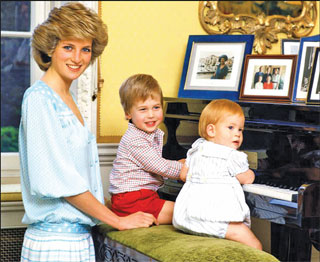 |
|
Princess
Diana with Prince William and Harry |
Within hours, a carpet of flowers began spreading from her home at
Kensington Palace in London as Britons threw off their reserved
reputation and mourned openly. In one of the defining moments of his
time as prime minister, Tony Blair described her as the "people's
princess", striking a chord with the grieving nation.
Yet Queen Elizabeth II appeared to have misjudged the public mood,
initially choosing to remain at Balmoral in Scotland instead of
returning to London.
Amid accusations she was out of touch and acting coldly towards her
former daughter-in-law - Diana and Prince Charles had divorced in 1996 -
the queen eventually made an unusual televised address.
Diana's funeral was heavy with emotion, not least when her brother
Earl Charles Spencer used his sermon to attack the press who had pursued
her throughout her adult life and who might have contributed to the
crash which killed her.
Perhaps nothing illustrates the passage of time since Diana's death
better than the bewildered little boy who walked behind her coffin - the
grown-up Prince Harry, now 27, made a very different public impression
in recent days after his wild 'strip billiards' holiday in Las Vegas.
Despite her younger son's sometimes raucous behaviour, Diana's legacy
can be seen clearly in her two sons and in William's wife Catherine, the
former Kate Middleton, according to royal historian Kate Williams.
 |
|
Diana in
the early years of her marriage |
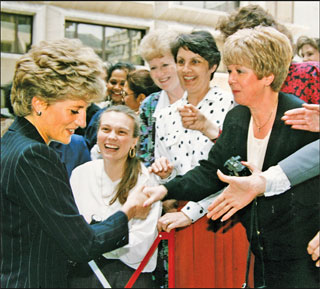 |
|
The
People’s princess |
"In the last three or four years the young princes have really taken
over a lot of the mantle of Diana, so we think less about Diana and more
about William, Harry and Kate," Williams told AFP.
"It seems as if the young royals are very much in Diana's mould. They
are giving to charity, they are very caring and they are out there
meeting the people and seem much less stuffy."
Even before her divorce from Charles, Diana had thrown herself into
charity work, especially championing the plight of landmine victims.
Shortly before she died she visited Bosnia to meet people maimed by
landmines.
Williams believes that if Diana were alive today she would be heading
up her own charity.
"Diana had a very good divorce settlement and she was a great
humanitarian and it is my belief that she would have spent that divorce
settlement on setting up her own charity in which she did work for the
poor, the sick and landmines victims."
She would have taken a role akin to a UN Goodwill Ambassador, such as
Queen Rania of Jordan or Hollywood actress Angelina Jolie, Williams
believes.
Diana's death continues to resonate. Tourists visiting the memorial
fountain to her in Hyde Park this week vividly recalled the
shock.Stephanie Cooper, a tourist from Billericay in Essex, said: "It
was one of those moments like the New York attacks, it is one of those
things like the death of JFK, you will always remember where you were
and what you were doing."
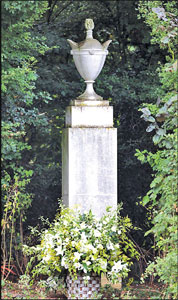
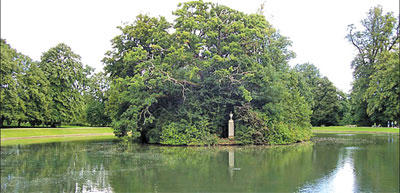 |
|
Princess
Diana’s grave |
Filming has started on a new movie starring British actress Naomi
Watts as Diana. Based on the recollections of her long-time bodyguard
Ken Wharfe, it shows her being hounded by the paparazzi.
Diana's death was not the only factor in the royal family's lack of
popularity in the late 1990s - a succession of divorces and scandals had
also eroded their image.
"It made people in Britain very confused about what people expected
from their royal family - were they not expected to set an example?"
Williams said. "But things have changed - the royals' popularity has
really soared and the queen is at her most popular since she came to the
throne in 1952."
Landmark events such as the wedding of William and Catherine last
year and the queen's diamond jubilee this year have boosted the royals'
standing - the queen even appeared in a spoof film parachuting into the
Olympics opening ceremony.
"The royal family have tried very hard to market their image since
Diana," Williams noted.
AFP
Mobility orientation of Sri Lankan migrant workers
Senali s. Perera
The mother or the father of the family is leaving for a foreign
country with a heart full of hope, praying that they will be able to
provide their family -their children with a better life ahead. But have
you ever wondered what exactly drives people to migrate?
Professor Tudor Silva explored this issue at the Thirteenth National
Convention on Women's Studies which was held recently at the Sri Lanka
Foundation (SLF). The convention was organized by the Centre for Women's
Research (CENWOR) Sri Lanka.
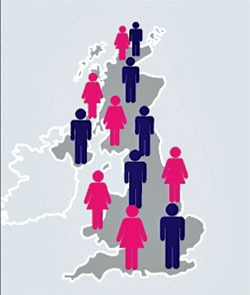 According to Professor Silva, mobility orientation can be discussed
under two dimensions. Spatial mobility, which means a person moving from
one place to another and social mobility. The desire to move up in
society. The desire to move up particularly from a low social
background. "This is a very important drive in our society as we know,
at least from the 50's onwards. But in this instance, the desire to move
up is combined with a desire to move out of their existing social and
spatial configuration," says Prof. Silva. He states that in trying to
understand their mobility orientation, we need to firstly understand why
they need to move out of their existing social and spatial setting. According to Professor Silva, mobility orientation can be discussed
under two dimensions. Spatial mobility, which means a person moving from
one place to another and social mobility. The desire to move up in
society. The desire to move up particularly from a low social
background. "This is a very important drive in our society as we know,
at least from the 50's onwards. But in this instance, the desire to move
up is combined with a desire to move out of their existing social and
spatial configuration," says Prof. Silva. He states that in trying to
understand their mobility orientation, we need to firstly understand why
they need to move out of their existing social and spatial setting.
"In order to do well you have to get out of where you are." Professor
Silva said that this can be right in most cases. But why do they want to
go? Don't the stories about children of migrants getting abused and the
bad press that this whole migration issue has been getting recently
scare them away? It seems they don't. But why, in this scenario, would
people want to leave their homes? Let's explore.
"According to 2009 reports from Sri Lanka Bureau of Foreign
Employment, the gender gap in migration for overseas work has reduced
from 2000 onwards. Now it's almost 50/50 and now actually more males
annually migrate compared to women. But still women's migration is quite
significant," Prof. Silva stated further.
Significance of female migrants
"When it comes to female migration purposes, most of them are
employed in domestic work," says Professor Silva. "In some ways, the
difficulties they're facing in this global economic market remain
unchanged." They come from different social backgrounds -urban poor,
rural poor, ethically marginalized, Muslim/Tamil communities and
depressed caste balance. "They find that their opportunities are
restricted in the local labour market. So they're looking for ways to
get out of the oppressive and in some ways restrictive environment in
which they live." s
Personal attributes of the female migrants
According to Prof. Silva, mostly the female migrants have low level
of educational achievements. "A study by the National Institute of
Social Development in 2010 shows 77% of the migrant workers in the
certain sample has had only primary education. Also, the migrants have
limited employment opportunities, a particular orientation toward social
mobility and/or they can be temporarily running away from
alcoholic/abusive husbands. "Not only they're from low social
backgrounds but their opportunities are also restricted because of the
oppression by male power."
Mobility Orientation
People see that by immigrating they have the advantage of quick
earning. They might believe that "the only way of progressing in life is
getting a high income in a short period of time," says Prof. Silva. And
the advertisements put up by employment agencies take advantage of this
mobility orientation. They show the bright side of migration and
sometimes even exaggerate it. And people -women are persuaded to make
this certain decision.
They repay their loans after getting wages. Their housing is
improved. "Often migrants from social backgrounds like urban poor, rural
poor include housing as one of the things they want to quickly achieve.
Their first investment is towards building or expanding the houses,"
says Prof. Silva further. "A house is not just a place for living but
also a status symbol."
And they buy household possessions such as jewelry, TVs and mobile
phones. And the education of their children is secure.
Then what are the omissions? Are there any? According to Prof. Silva,
most immigrants have no plans for investment. No plans for livelihood
developments. They might have many plans how to spend their earnings,
but more often than not, they are not interested in investing.
Risk assessment
The risks of migration can be observed as neglect of children - when
children of the immigrants are left without parental care, disruption of
children's education, abuse of girl child in particular -when a mother
is not with her daughter; the security and the protection of that child
are at risk. There are risks of that child getting abused in the absence
of her parent. Then what about the male child? We can hear stories about
sons of immigrants being abused as well. "This is a largely unexplored
issue in Sri Lanka. It requires further attention and it must be
prevented," said Prof. Silva.
More risks are potential abuse of workers in the work place, wastage
of remittances by spouses/family and incomplete housing - housing
development started but never completed. They might have grand housing
plans that are unrealistic and their earning will go straight for it but
in the end it will be left without any more attention, a plan that
simply didn't work out. A solution has to be found as to how to
encourage a shift from consumption to investment. Mutual support and
exchange of information among migrant workers should be promoted because
this information can be more accurate and new migrants can be guided
more successfully by the information provided by more experienced
migrants.
It is also important to know how to promote skilled migration. A
shift from less remunerative employment to more remunerative employment
should be encouraged. All types of abuse by agencies and employers must
be prevented.
"Family migration instead of migration of men and women separately is
something we should look at. Perhaps that will be better for mutual
protection. And perhaps it might bring better benefits for the migrants
and the country at large," concluded Prof. Silva.
Leaving one's family and home behind and emerging into a whole
different, unknown world is by no means easy. It can be risky and it
might require boundless courage and sacrifice. It is a struggle for
survival. So in the end, the struggle should not go to waste. Everyone
deserves a brighter, happier life. |





